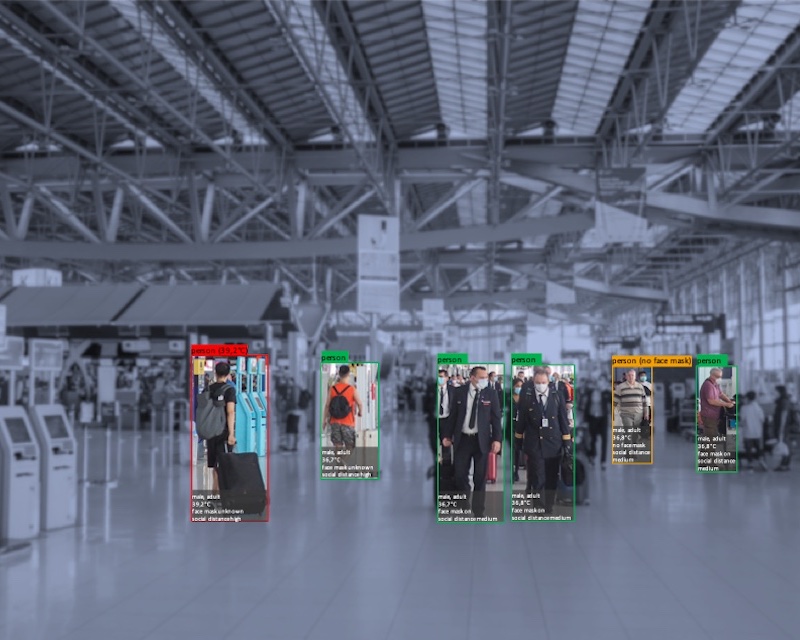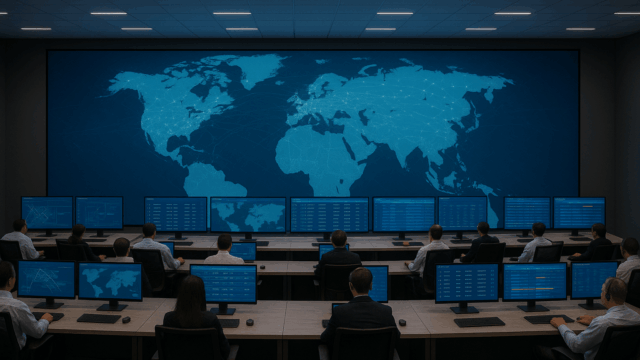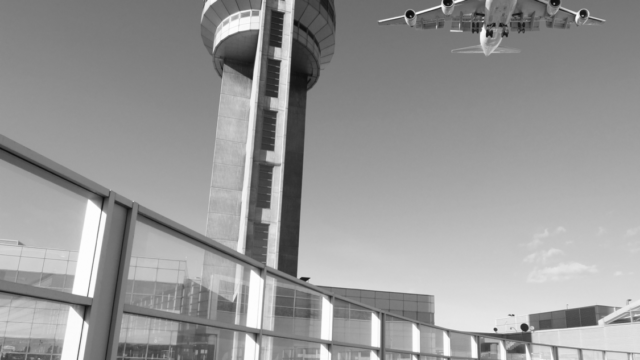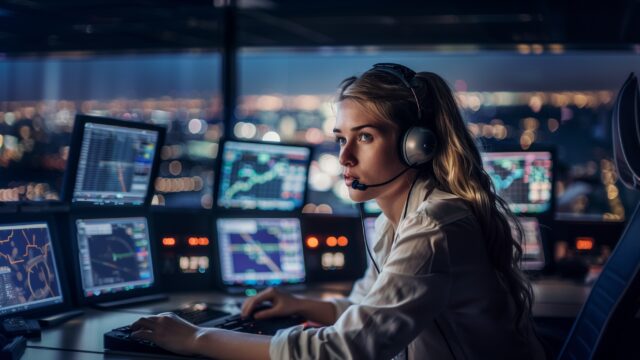
Introduction
For several month the COVID-19 outbreak has limited public and professional life globally. Air travel and tourism have been especially impacted by a wave of measures designed to prevent the spread of the virus. As the peak is past and the lockdown is being lifted, public life in most European countries is coming back. However, several hygiene regulations impacting air travel and tourism still need to be followed. Specifically, airports need to adapt their hygiene regulations in order to ensure safe and stable operations. In order to do so, they need to set up processes, organize staff to manage the processes, and more, all of which will cost time and money. Video Analytics is one of the solutions that helps airports to automate the control of COVID-19 measures. In this article, we will explain how the hygiene regulations affect airport operations, what Video Analytics is, how it will help airports, and what the Video Analytics market looks like.
The air travel industry, one of the sectors most affected by the pandemic, is awakening from the shutdown. Airlines in Europe are slowly ramping up their operations again. Lufthansa, Eurowings, Wizz Air and other airlines are increasing steadily the number of flights. Ryanair plans to resume flights to all of its destinations beginning in July. For airports, this means that passenger numbers will rise again. There is currently much speculation about how quickly air traffic will return to pre-pandemic levels. However, experts estimate that the aftermath will endure for two to three years.
Airports Must Take Measures to Prevent the Virus from Spreading
As already outlined in our previous article on how airport operations will be impacted by COVID-19, airports, as hubs for thousands of travelers, must take measures to restart operations while simultaneously complying with hygiene regulations, such as the following:
- Barrier tapes and floor markings in queues at check-in, security, passport controls, lounge entrances, and other areas must be set up.
- Face masks must be checked.
- In many countries, airports are obliged to take fever measurements.
- Bus boarding must either be avoided or more buses must be used to reduce the density of people.
Other Measures are also necessary, such as:
- the installation of plexiglass panes at counters with airport staff,
- wearing nose and mouth protection,
- and the provision of disinfectants.
In addition to these measures, many airports have already started to inform passengers about hygiene regulations and distance rules via posters, information displays, and social media.
All these measures are presenting airports with organizational and financial challenges, forcing them to rethink. Staff must be allocated, organized, and managed to carry out checks on hygiene regulations. Financial resources, already scarce due to the crisis, must be properly allocated to the measures. Concepts and solutions must, therefore, be developed and implemented in order both to support and automate the control of hygiene regulations and to financially relieve the airports. One possible solution for the current situation is Video Analytics.
What Exactly is Video Analytics?
Video Analytics is a technology that transforms unstructured data such as images or video material into structured information. It analyzes images captured by, for example, surveillance cameras and provides information about the specific content it recognizes. The latest Video Analytics solutions are using artificial intelligence technology (AI), which is a computer system that exhibits characteristics of intelligence such as machine learning (ML). Through ML a system, also called model, is able to understand interrelationships and is able to learn based on them. It is essentially a mathematical algorithm trained with big datasets. Each time the model gives an incorrect output, the model is adjusted in such a way that upcoming outputs lead to conclusive results, overall becoming much more efficient.
There are many ML algorithms; one of the most well-known ones today is Deep Learning. Inspired by the human brain, a Deep Learning algorithm can understand even complex relationships based on their characteristics and interpret them correctly with a very high probability – as long as it is well trained. This allows AI systems, similar to the human brain, to recognize new but familiar situations, objects, and interrelationships.
In the context of an airport journey, Video Analytics simplifies and also automates the control of hygiene regulations and the detection of people suspected of carrying coronavirus. For example, it can detect people in an airport terminal with and without nose-mouth protection, and, with thermal cameras, people with high fever within a crowd. Video Analytics solutions also help to detect whether distance regulations are being complied with. Sophisticated systems can also detect people with conspicuous behavior and repeating patterns, such as coughing, sneezing, or stumbling to the ground.
Such systems detect risks independently and, in combination with other systems and depending on the application, can either:
- either inform airport staff,
- control access via a traffic light system,
- or deny access by blocking automatic doors.
Thanks to the amount of offered solutions, Video Analytics can be integrated into any existing camera-based surveillance system with relatively little effort. In the long run, Video Analytics will contribute to safe airport operations, even beyond the effects of COVID-19.
What Does the Video Analytics Market Look Like?
We looked at the market and compared the existing Video Analytics solutions. Both startups and large companies offer solutions in different forms. These forms can be categorized in two ways – Solution Type and Application Range.
Solution types:
- Software application – Certain solutions can be easily integrated into the existing infrastructure and system landscape. This is the case if a mere Video Analytics software solution is applied, providing a user interface and an API. It uses the video stream of cameras already in place. Depending on the quality (e.g. resolution) of the existing devices, no installation of new cameras is needed.
- Software with external plug-and-play hardware – An additional solution group includes software with external plug-and-play hardware which is plugged into existing cameras. This solution type is also known as edge analytics. The external device transforms the video stream into structured data which can be analyzed and used for operational management.
- Cameras with built-in Video Analytics processor – This solution type is similar to the previous one, the difference being that the processor is integrated into the camera. The camera enables edge analytics and the video stream is directly transformed into structured data which can be analyzed and used for operational management.
Application Range
At the same time, Video Analytics solutions have a high degree of variability regarding the application range and consequently the number of use cases they are applicable for. The application range indicates the extent to which a given Video Analytics solution suits relevant use cases for pandemic containment:
- Incident Detection
- People/Crowd Counting
- Fever Detection
- Social Distancing
- Suspicious Person Detection
- Mask Detection
- Facial Recognition
Consequently, the market of Video Analytics vendors and the respective products can be placed along these the two dimensions, solution type and application range (see Figure: Market Landscape). The pie charts indicate the number of vendors that can be grouped together regarding the solution type and the application range of the products offered compared to all the 27 companies screened. One can see that many solutions only cover a small number of relevant use cases for pandemic containment.
What Should Airports do Next?
To understand which Video Analytics solution suits your airport the best for pandemic containment, you should first evaluate your needs. The following general questions should be answered:
- Which use cases should be covered by the appropriate solution?
- How should Video Analytics be embedded into the process and system landscape?
- Which technical requirements should the cameras fulfill?
- In which areas of the terminal should Video Analytics be used?
- How many new cameras should be installed?
In cases where high quality cameras are already installed, a Video Analytics software should be considered. If no such hardware is already in place, e.g. in a newly built terminal, an edge analytics solution with new cameras may be considered. The following general questions should be answered:
- Does the service or product meet all of your needs?
- What are the implementation and yearly operating costs?
- How does the provider deal install and integrate his solution into your infrastructure?
- What does the service level look like?
Based on your answers, you should also consider whether to install a full-service solution or combine different solutions to gain the best result at a lowest cost. COVID-19 will change aviation dramatically and no one can currently say when everything will return to ‘business as usual’. Airports must, therefore, adapt to this ‘new norm’, considering solutions, such as Video Analytics, in order to ensure stable and safe operations.




